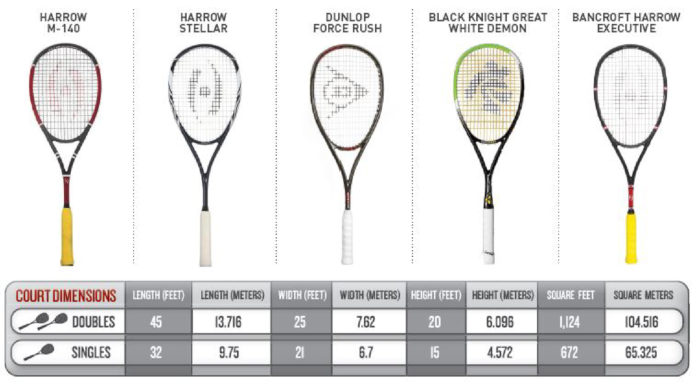by Pierre Bastien
Hardball doubles is a gem of a sport with an avid fan base throughout North America. It’s incredibly fun and full of interesting variations you don’t see in squash singles.
The patterns of play are much different in doubles than they are in singles. For one thing, you have a teammate, who is usually standing on the other side of the court from you—except when I team up with my friend Peter, when we invariably work ourselves into an unorthodox I-formation. Spacing is essential; the court has 60% more floor space than a singles court. You can hit a doubles ball with a lot more pace and weight than a singles ball. It’s very difficult to flick the ball in a wristy manner—especially if you’re responding to a shot that is barreling towards you. This affects doubles players’ racquet choices.
Characteristics of Doubles Racquets
Doubles players generally prioritize stability and sturdiness over maneuverability in their racquets. Some typical characteristics of doubles racquets are:
• Bridged throat. Doubles racquets usually have a traditional bridged throat, as opposed to the teardrop shape that’s more commonplace in singles. This gives the racquet much-needed extra stability on impact.
• Heavier. Doubles racquets also tend to be a little heavier, and a little head-heavier, than singles racquets, in order to guide your swing through the ball cleanly.
• Higher String Tension. Doubles players tend to string their racquets at higher tensions to better control the pace of the ball. Typically, they should be strung nearer to thirty to thirty-two pounds, compared to twenty-five to twenty-eight pounds in singles. Professional-level doubles players often string their racquets even several pounds heavier than that range.
• More Strings. Doubles racquets also tend to have denser stringing patterns than singles racquets, again to better withstand the ball’s impact.
Popular Doubles Racquets
Harrow is currently the most-used brand in the doubles market. They’ve placed significant focus on hardball doubles for years and have come up with frames that are well-liked by players and widely distributed in pro shops. Dunlop is making more of a push into the doubles market, alongside other major squash brands—including Black Knight and Manta—which have come out with their own doubles-specific frames, often at lower prices to carve out a space for themselves in this popular and growing market. Like with singles racquets, the best approach is to demo a few options to see what fits your personal game the best. Often the factory strings won’t provide an accurate feel for the racquet, so a good approach is often to use a friend’s restrung frame in a test match (they will probably agree, because if you break it during play, you owe them a new one!).





